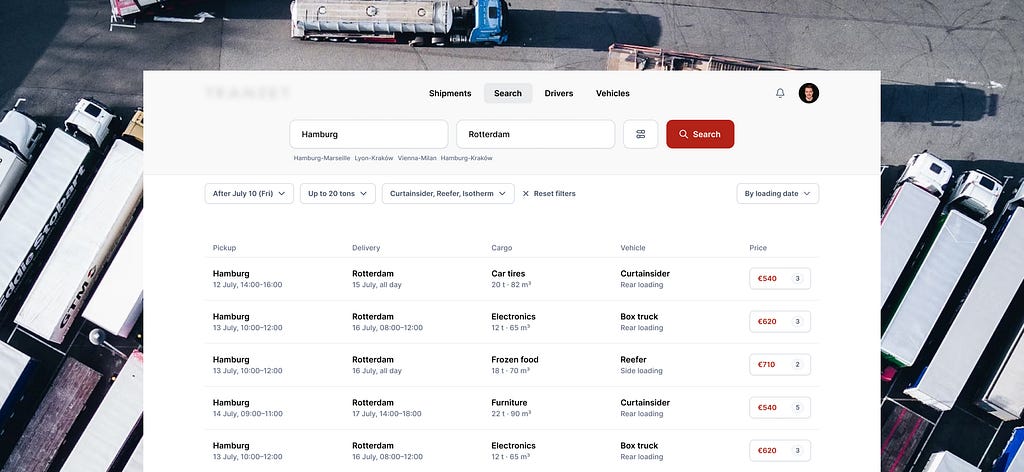How to Build a Successful Product: Lessons from Launching and Growing a Freight Transportation Platform
I joined the company as the first full-time employee and, over five years, tried on multiple roles — from product design to strategic planning. I helped the product evolve from an idea to a market-ready service, went through one pivot, and gathered a lot of insights along the way. Here’s what I learned — I hope these lessons help you avoid common mistakes in your own journey.

The Business Plan Stayed on Paper
On my first day, the CEO handed me a thick folder detailing how the service would grow. I never opened it again. The market quickly pushed the product in an entirely different direction.
That said, having a plan is important — especially for designers and developers, as it helps align the vision and lay the groundwork for future features. But it’s just as crucial to adapt that plan based on real user feedback. The key is not to pivot constantly. Structure your work into clear stages with hypotheses and measurable goals. Confirm or reject them with data.
Our investors weren’t used to this iterative approach — they wanted a one- to two-year roadmap. That’s understandable. They’re putting money into something and want predictability. That’s why it’s essential to clearly explain how the product development process works — and why agility is often more valuable than a fixed plan.
Collaboration with Developers
In every project, I aim to establish close communication with the dev team from the very beginning. I need to understand which tech stack will be used so I can choose a compatible design system that works for both design and frontend. This significantly speeds up development and improves teamwork.
There’s no point in creating overly custom UI components if they’ll be difficult and time-consuming to build and maintain. It’s more efficient to use existing components and focus on functional development. Many modern design systems evolve alongside current technologies and are reliable choices.
Another point: I prefer direct communication with developers — skipping middle layers like managers and analysts when it comes to small questions. Analysts are great for gathering requirements, and managers help with setting priorities, but quick iterations happen faster through direct contact.
MVP: Not Just Usable, but Valuable
We quickly defined what our MVP should include. It took six months to develop. We tested usability by inviting users, giving them tasks, and observing their behavior. But we missed one crucial thing — testing the product’s value.
In other words, it was usable, but not useful. It only solved rare use cases for our target audience. I had to conduct dozens of user calls to understand where we went wrong and what direction we should pivot toward.
Changing plans is normal for any startup. The main thing is not to delay validating your hypotheses. Tie every stage to measurable metrics and check them through user interaction and data analysis.
Metrics and Feedback
I closely monitored key product metrics — how many users reached the registration page, confirmed their phone number, signed a contract, placed their first order, and so on. I focused on drop-off points in the user journey.
For example, I noticed high traffic to the registration page but very few completions. After a series of calls, I realized that transport providers didn’t believe there were real shipments on the platform. So they left, even though the concept seemed promising to them.
To solve that, I added a list of active shipments to the registration page. Conversion immediately improved — people saw a reason to sign up.
Users Don’t Need Your Product
They need solutions to their problems. That’s the real goal: understand what jobs users are trying to get done, how they do it today, and then simplify that process significantly — so much that switching to your product becomes the obvious choice.
Alongside user interviews, I analyzed global competitors. When I couldn’t access their product directly, I studied help centers and even job descriptions to understand the workflows behind the scenes.
But even solving the problem better isn’t enough. User habits are strong. To win them over, you need a solid transition strategy — and that means deeply understanding their current way of working.
Conclusion
Building a successful product isn’t about sticking to the original plan — it’s about listening, iterating, and constantly testing assumptions. Over these five years, I’ve learned that the market will show you the way if you’re willing to observe and adapt.
Mistakes are part of the process. What matters is how fast you learn from them and move forward. The faster you validate your ideas with real users, the closer you get to building something truly valuable.
How to Build a Successful Product: Lessons from Launching and Growing a Freight Transportation… was originally published in UX Planet on Medium, where people are continuing the conversation by highlighting and responding to this story.